Abstract
This article focuses on the application scenarios of stablecoins. Stablecoins have special advantages in payment scenarios, and the market is particularly concerned about stablecoins' efforts in traditional payment fields, especially cross-border payments. There is a "non-homogeneous" characteristic between different stablecoins, which makes the competition among stablecoins particularly fierce. At present, the tokenization of US stocks and AI Agent are important tracks for application promotion, which will have a siphon effect on the liquidity of the global financial market.
Stablecoins have a simple account system, and Tokens are separated from the bank account system, making transfers between users extremely convenient, with the characteristics of payment and settlement - this forms another sharp contrast with the traditional financial system.Traditional financial accounts are provided by various financial institutions as centralized nodes, providing financial services. Financial institutions are responsible for maintaining users' accounts and financial infrastructure, and charging users related fees. The transfer of money between stablecoin users is extremely convenient. Traditional cross-border remittances, international payments, and even stock transactions cannot achieve payment and settlement, and they all need a certain amount of time to complete the final settlement and delivery. On the other hand, the establishment of accounts in traditional financial institutions is much more complicated than blockchain accounts, and the light account characteristics of blockchain make it easy to register an account as long as there is a network and a mobile phone terminal.
The "non-homogeneity" characteristics of stablecoins make the market competition very fierce. Although stablecoins of the same currency are equivalent in value, stablecoins issued by different issuers still have the characteristics of "non-homogeneity". For example, as a stablecoin variety under Coinbase, the transaction volume of USDC trading pairs is about 1/8 of USDT. The market competition of stablecoins will be very fierce, and the test is the scenario versatility and promotion ability of stablecoin varieties.
The tokenization of US stocks is an important track that is expected to accelerate its implementation in the future. At the same time, the integration advantages of Agent and stablecoin accounts will have a siphon effect on global financial liquidity. Stablecoins, as "legal money" on the chain, play the role of infrastructure tools. Stock tokenization is expected to become the next scenario for the accelerated landing of stablecoins, and is the variety with the most planned promotion potential in RWA. In addition, stablecoin accounts are naturally integrated with AI, which is a very friendly choice for AI Agent payment. Stablecoins are built on blockchain light accounts and are native assets on the chain, which is very suitable for AI Agents to control accounts to realize payments. These two application scenarios will have a siphon effect on global financial liquidity. At the same time, how do individual users and enterprises keep cryptocurrency assets? For enterprises, private key management is an even more complex issue. In short, this involves systematic construction such as asset security, internal control, compliance, and coordination among multiple countries.
Investment strategy:Stablecoins and RWA will continue to be hot topics in the market, which will be catalyzed by the landing of applications in the United States and the licensing process of stablecoins in Hong Kong, China, and the stock tokens and Agent interactions we mentioned are expected to become a new hot spot. We recommend watching US stocks: Circle (CRCL), Robinhood (HOOD), Coinbase (COIN), Microstrategy (MSTR), Futu Holdings (FUTU), etc.; Hong Kong stocks: ZhongAn Online (HK6060), LianLian Digital (HK2598), Hengyue Holdings (HK1723); A-shares: Sifang Jingchuang (300468), Zhongke Jincai (002657), Hengbao Shares (002104), Langxin Group (300682), etc.
Risk warning: Blockchain technology research and development is not as expected; regulatory policy uncertainty; Web3.0 business model implementation is not as expected.
1. Core view
Stablecoins, as cryptocurrencies, have special advantages in payment scenarios. The market is particularly concerned about stablecoins' efforts in traditional payment fields, especially cross-border payments for international trade. At the same time, as cryptocurrencies, different stablecoins (even if they are anchored to the same legal currency) are homogeneous tokens, but due to different promotion channels and scenarios, they are naturally "non-homogeneous", making the competition among various types of stablecoins particularly fierce. From the current perspective, the tokenization of US stocks and AI Agent will be the two important tracks for the promotion of stablecoin applications, which will have a siphon effect on the liquidity of the global financial market.
This article analyzes the prospects of stablecoins entering the payment field, and looks forward to the role of US stock tokenization and AI Agent in promoting stablecoins, and explains the establishment of regulatory and compliance systems.
2. Stablecoins and traditional payments: two-way travel
2.1 Stablecoins enter the traditional payment field: innovation in cost and settlement model
As a cryptocurrency backed by fiat currency assets, stablecoins naturally have the characteristics of peer-to-peer and decentralized blockchain accounts for transfers between accounts. Users have control over their accounts, and the blockchain infrastructure is maintained by miners. This is very different from traditional fiat currency (and other financial) accounts. Traditional financial accounts are provided by various financial institutions as centralized nodes, providing financial services. Financial institutions are responsible for maintaining users' accounts and financial infrastructure, and charging users relevant fees. The simple account system of blockchain makes it extremely convenient for users to transfer money, and it has the characteristics of payment and settlement. This is in sharp contrast to the traditional financial system. Traditional cross-border remittances, international payments, and even stock transactions cannot achieve payment and settlement. They all take a certain amount of time to complete the final settlement and delivery. In addition to regulatory reasons, the working mode of traditional financial institutions as centralized intermediaries limits their settlement speed. On the other hand, the establishment of accounts in traditional financial institutions is much more complicated than blockchain accounts. For example, for many underdeveloped areas without banking services, it is not easy for people to obtain bank accounts. The light account characteristics of blockchain make it easy to register an account as long as there is a network and a mobile phone.

The above characteristics of blockchain are precisely the advantages of stablecoins in the traditional payment field. Therefore, in some communities in underdeveloped countries, people can still register blockchain accounts through mobile phones and use stablecoins for daily remittances and retail payments, especially the use of US dollar stablecoins to cope with the depreciation of their own currencies. Interestingly, these regions may not even have banks that provide US dollar account services, but they can use US dollar stablecoins to make US dollar payments, which can be described as "overtaking on a curve".
As shown in the figure below, the USDT stablecoin deployed on the Ethereum blockchain has a transfer of about 2477 USDT, and the miner charges a handling fee of about US$0.23 (paid in ETH tokens). This remittance transaction was confirmed by the miner and entered into the blockchain after the transfer initiator initiated the remittance transaction, completing the settlement.
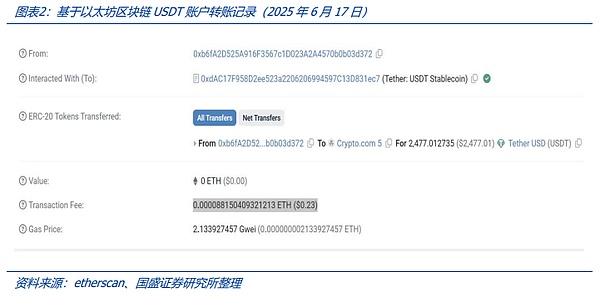
Of course, it is worth noting that the settlement speed of blockchain is limited by the impossible triangle (that is, decentralization, security and efficiency cannot reach the optimal value at the same time). When the network carries too many remittance transactions, the network settlement speed of blockchain will be subject to certain restrictions, and the fee rate will also increase according to the situation. Therefore, if stablecoins want to be widely used in the payment field, more expansion measures are needed.
2.2 Traditional giants are actively embracing stablecoins
Recently, many giants in the traditional Internet and retail fields have shown great interest in stablecoins. Walmart and Amazon are both exploring issuing their own stablecoins in the US dollar to reduce payment friction, speed up settlement and reduce costs associated with traditional financial channels; the Stablecoin Ordinance of Hong Kong, China will officially take effect on August 1, Ant International and Ant Digits have expressed their intention to apply for a stablecoin license in Hong Kong, and JD.com's stablecoin has entered the second phase of sandbox testing. Traditional big companies are actively embracing stablecoins. Take the payment giant Paypal as an example. As of the end of 2024, its company has more than 430 million active consumer and merchant accounts and more than 1.68 trillion US dollars in payments. The US dollar stablecoin PYUSD (Paypal USD) launched by PayPal and Paxos realizes stablecoin payments in millions of online stores. Relying on such a payment giant with a considerable amount of application scenarios, what is the current status of its stablecoin application?
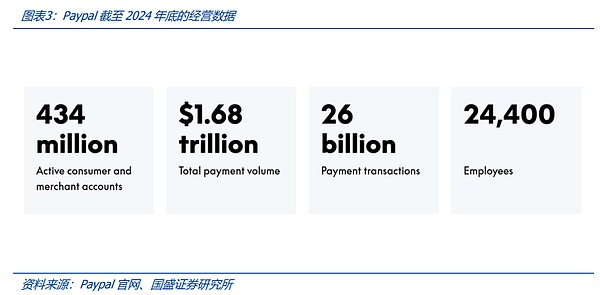
But in fact, as of June 17, 2025, the supply scale of the stablecoin PYUSD is only about 950 million US dollars, and the development is not satisfactory. This seems unexpected, but it is related to the competitive advantage of stablecoins. Taking the US dollar stablecoin as an example, different issuers have promised to redeem their stablecoin products against the US dollar at a 1:1 ratio, and there is no difference in their value. We can compare it with legal currency. In actual application, there is no difference between the US dollars in different bank accounts, but even if they are all US dollar stablecoins, different currencies face inevitable competition. This is another manifestation of the programmability of stablecoins-from the perspective of computer program code, there are differences between stablecoins. We will explain the analysis of the competitive advantages of different varieties of stablecoins anchored to the same legal currency later.
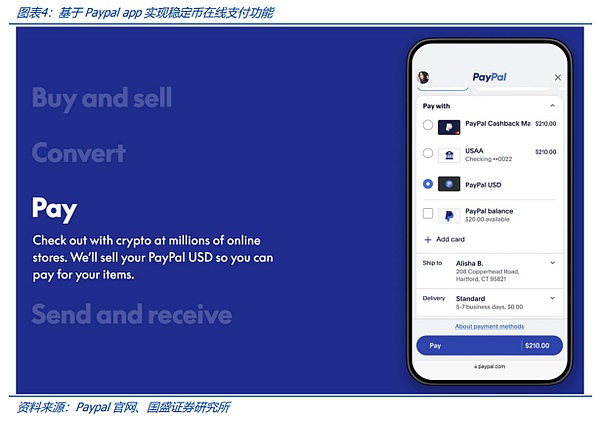
In short, as a new species, stablecoin products face a special market competition logic. Even for traditional large companies, in the new field of stablecoins, if they want to promote products to seize the market, the challenges they face must follow a different market logic than before. Therefore, whether it is a large company or a startup, there will be certain potential possibilities in the stablecoin track.
3. The market competition of stablecoins will be very fierce
3.1 “Non-homogeneity” determines the universality of the scene chain is the key to competition
Although stablecoins of the same currency are equivalent in value, stablecoins issued by different issuers still have the characteristics of “non-homogeneity” - after all, from the perspective of blockchain programs, cryptocurrencies themselves exist in different codes. Taking the US dollar stablecoin as an example, although different types of stablecoins are promised by their respective issuers to be pegged to the US dollar at a 1:1 ratio, on the blockchain, just like different USB interface adapters are not the same, stablecoin varieties also have certain “non-homogeneity” characteristics. USDT and USDC are the leading stablecoins. The transaction volume of stablecoin pairs in Coinbase is different. What is very interesting is that the transaction volume of USDC, a stablecoin under Coinbase, is quite different from that of USDT. As shown in the figure below, referring to the data on June 16, 2025, the transaction volume of stablecoin pairs on Coinbase is almost one-eighth of USDT.
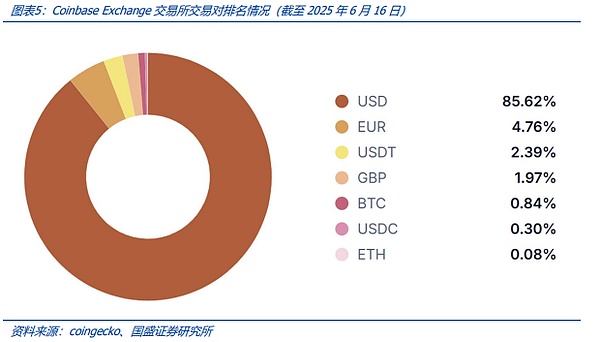
USDTAs the largest stablecoin, its versatility is the key to market competitiveness. As we all know, stablecoins are widely used in centralized exchanges (CEX) and DeFi platforms on multiple public chains (including decentralized exchanges DEX, pledge lending platforms, derivatives platforms, etc.). Not only that, USDT is also the most widely recognized and used even among community residents in underdeveloped countries. USDT has more than 400 million users in developing countries, mainly used for remittances, services for unbanked users, and as a savings tool denominated in US dollars. Residents in some areas of Africa, Central America and South America generally rely on USDT to resist the depreciation of local currencies. It can be seen that the acceptance service of USDT and legal tender is also active as a supporting service in the local area. It is precisely this versatility in the application scenario chain that makes USDT the most widely accepted tool and the largest USD stablecoin. As of June 17, 2025, the scale of USDT exceeds 156 billion US dollars, and the scale of the second-ranked USDC is about 61 billion US dollars.
Therefore, we believe that under the background of the introduction of stablecoin-related bills, the issuance of stablecoins itself does not have too many thresholds (and the infrastructure is often deployed based on existing public blockchains). The key to large-scale development lies in the versatility of the scenario chain - that is, whether a stablecoin variety can be used in multiple application scenarios and accepted by a wide range of user groups - this constitutes the moat of stablecoin varieties. This is an important reason why USDC, a stablecoin variety under the Coinbase exchange, has a transaction volume of only one-eighth of USDT. As mentioned above, the stablecoin PYUSD supported by the payment giant Paypal has a scale of less than US$1 billion. We believe this is the reason.
3.2 Opportunities and Challenges of Stablecoins in Exploring New Payment Systems
In the traditional payment system, the process of international payment is the most complicated, involving multiple financial intermediaries such as payment institutions, intermediary financial institutions, and financial institutions where user accounts are located, and involving conversions between multiple currencies. The light account system of blockchain payment and clearing is significantly different from traditional payment. Therefore, if stablecoins are integrated into the traditional payment system, it is necessary to build corresponding infrastructure and services.
The simplest scenario is, for example, userAUS dollar stablecoin remittance to userB, and convert it into Hong Kong dollar stablecoin. Here, it is necessary to design a remittance service between stablecoins. At the same time, it is also necessary to connect the stablecoin account system with the traditional legal currency payment and clearing system. This requires the establishment of an international payment system, involving payment rules, regulatory regulations, financial service providers and IT infrastructure. The integration of stablecoins and traditional payment systems requires the construction of hardware infrastructure and services. Currently, stablecoins are mainly used in retail payment and remittance scenarios. In the future, the market with greater potential is to expand stablecoins to B2B payments and cross-border trade payment systems. Stablecoin B2B payment and cross-border trade payment are potential markets that the industry continues to pay attention to. Previously, payment giant Stripe acquired the stablecoin trading company Bridge for US$1.1 billion. Recently, the company announced that stablecoin financial accounts using Bridge technology now cover 101 countries/regions. These institutions can receive payments through cryptocurrencies or bank transfers and use stablecoins for global payments. Stripeis trying to connect stablecoin payments with traditional bank payment systems, which brings new development potential for stablecoins in the payment field. As shown in the figure below, throughBridgeusers can useUSDB(Bridge Stablecoin) issued and managed byBridge.The stablecoinsissued byBridgecan be exchanged with most stablecoins or fiat currencies throughBridge Orchestration API(transfer, clearing address and virtual account). Users use the Bridge API to send fiat currency or stablecoin to Bridge, and will receive Bridge stablecoin (USDB). Bridge manages USDB reserve assets in separate bank accounts and treasury custody accounts.
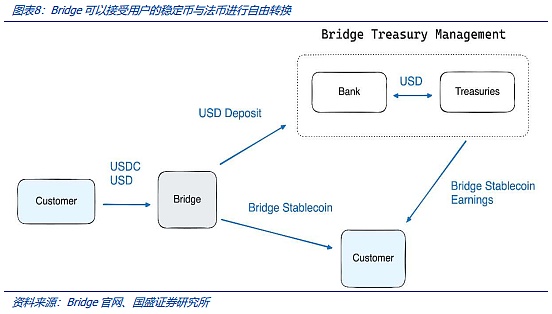
That is to say, when using the services provided by Bridge, users no longer deliberately distinguish between stablecoins (based on blockchain cryptocurrency accounts) or legal tender (based on traditional financial accounts). Bridge has integrated the two account systems in terms of payment, remittance and clearing.
Therefore, it is foreseeable that in the process of stablecoins entering the trade payment and international payment system, similar intermediary services for the integration and conversion of legal tenders/stable coins are indispensable. This new demand is expected to give rise to new business models such as related IT infrastructure providers and financial service providers.
Another challenge for stablecoin payment is payment efficiency. The traditional payment architecture is a centralized computing architecture, and centralized architecture is beneficial to efficiency. Let's take Alipay as an example. Its payment peak was 256,000 transactions per second during the "Double 11" in 2017. It can be seen that the traditional payment system serves hundreds of millions of users, and it is not a big problem to achieve a payment efficiency of 100,000 transactions per second. On the other hand, blockchain cryptocurrency, due to the characteristics of the decentralized architecture of blockchain, naturally limits efficiency. Taking Ethereum and TRON, two public blockchains deployed by USDT, as examples, the TRON chain can process more than 2,000 transactions per second, while the Ethereum main network only processes transactions in the double digits per second. Once the transaction heat increases, it will be congested. The data here is still in an ideal (network idle) state. As the network carries more tasks, the network will undoubtedly be congested. The payment efficiency of the blockchain network carrying millions of users will inevitably become a key technical architecture issue that urgently needs to be broken through.
4. Siphoning financial liquidity: U.S. stock tokenization (RWA) and Agent
U.S. stock tokenization is an important track forRWAtokenization, which is expected to accelerate the landing of, will drive the growth of demand for stablecoins. At the same time, the integration advantages ofAgentand stablecoins will have a siphon effect on global financial liquidity.
4.1 Tokenization of US stocks: A new catalyst worth looking forward to in the second half of the year
Stablecoin itself is a cash-based RWA (Real World Assets, tokenization of real-world assets), which has no investment value, but as an important on-chain "fiat currency" it has the role of an infrastructure tool. In addition to the stablecoin application scenarios described above, stock tokenization (Tokenized Equities) is expected to become the next big application market for stablecoins.
In the past few years, stock tokenization has been a "flash in the pan" in the development of the cryptocurrency market. The most representative one is Mirror protocol, whose platform provides users with various RWA products in the form of synthetic assets, including US stock tokenized assets such as Tesla, Google, Apple, and Microsoft (as shown in the figure below). Later, due to regulation, market fluctuations and other reasons, stock tokenization gradually became silent.
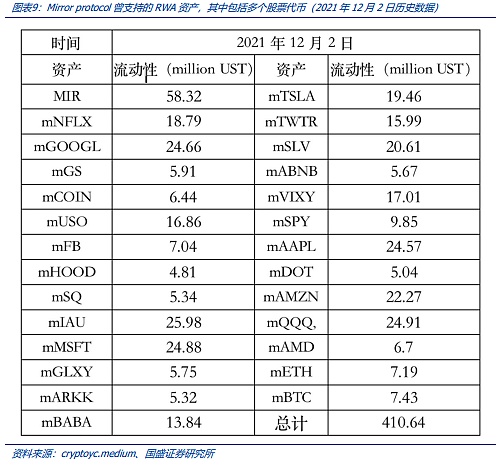
Today, as RWA is rapidly promoting regulatory follow-up, the market is no longer satisfied with the returns of treasury tokens, but instead pursues more flexible stock tokenization. Obviously, stock tokenization is a more attractive and huge market, providing more configuration options for cryptocurrency investors with different configuration needs. This direction has gained consensus from traditional financial institutions and cryptocurrency institutions, and stock tokenization is expected to receive stronger regulatory lobbying. Traditional financial institutions and cryptocurrency institutions represented by BlackRock are actively making suggestions to regulators to promote the implementation of stock tokenization. Recently, the cryptocurrency exchange Coinbase is seeking approval from the U.S. Securities and Exchange Commission (SEC) to provide "tokenized stock" transactions to users. The possible benefits of stock tokenization to cryptocurrency exchanges are self-evident.
Before this, Kraken, a long-established cryptocurrency exchange, planned to provide tokenized U.S. stock trading options to non-U.S. customers. On May 22, the all-crypto exchange Kraken announced that it would cooperate with Backed Finance to launch a tokenized stock and ETF trading service called "xStocks", covering more than 50 U.S. listed stocks and ETFs such as Apple, Tesla, and Nvidia.
It is foreseeable that stock tokenization is expected to accelerate its implementation, which will become an important application scenario for stablecoins, and the scale of the U.S. stock market is sufficient to promote the rapid expansion of stablecoins.
4.2 AI Agent payment is another potential market
Stablecoins are a very friendly choice for AI Agent payments. In the future AGI world, AI Agent will replace people to complete many tasks, which inevitably involve payment links. The payment process of traditional financial accounts, such as bank accounts, often requires user authorization, financial institution review and other processes. This complex multi-node authorization workflow is not friendly to AI Agent. In many applications, AI Agent does not involve direct control of accounts and payments - payment operations are still operated by staff, and stablecoins are built based on blockchain light accounts, which is very suitable for AI Agent to control accounts and realize payments.
We believe that the introduction of smart contracts by Ethereum not only opens up the scripting capabilities of blockchain, but also perfectly integrates AI intelligent decision-making with account payment. In other words, AI Agent is no longer just an intelligent assistant that provides analysis and suggestions, but can directly combine with user accounts to realize Agent's control of accounts. This is reflected in many blockchain applications.
Let's take the intent-centric application as an example to see how AI intelligence integrates decision-making and payment. For example, in the figure below, the user wants to exchange Token A (A token) for Token B (B token) according to a certain expected ratio (note that there may not be a ready-made A/B transaction method as expected by the user at this time). The user only needs to provide this demand target. As for the path taken in the process and the specific liquidity pool used, the user does not need to consider it. The intention application is an intelligent AI agent that helps users to conduct intelligent analysis and find the best transaction path (or transaction timing). Through the intention AI agent, as long as the user signs and authorizes with "one click", the result can be finally achieved. In the specific process, the intention protocol will optimize and solve the possible liquidity "routes" through the AI algorithm to find the best path to achieve the user's goal-this may involve multiple trading pools (i.e. exchanges on the blockchain) and other trading paths.
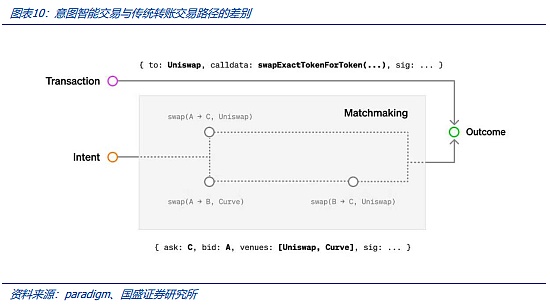
From the above analysis, we can see that the signature transaction of the blockchain account and the AI algorithm solution are highly integrated. This provides a certain basis for AI Agent to directly operate user accounts, that is, users can authorize with "one click" to authorize the user's operation rights to the AI algorithm. And this integration is universal, that is, the blockchain account is naturally a smart contract, which has the gene of AI itself, including flash loans, decentralized exchange DEX core protocol - AMM protocol (Automatic Market Maker, Auto Market Maker), etc., all reflect this feature. After stablecoins enter the payment field, Huoxue can use AI Agent to free users' hands and have a certain imagination space.
5. Regulation and compliance of stablecoins: a compliant payment system needs to be established
The establishment of a stablecoin payment system is a systematic project. How do individual users and enterprises keep cryptocurrency assets? Individual users can manage blockchain assets through private keys, but considering the threshold for using and managing blockchain wallets, this is not a universal solution. After all, if an individual loses or forgets his private key, he will completely lose the cryptocurrency assets in his account (blockchain is a decentralized account, without central servers or super account permissions). For enterprises, private key management is an even more complicated issue. The person who holds the private key has absolute control over the assets in the blockchain account, which involves moral risks. Of course, enterprises can choose to entrust cryptocurrency assets to professional institutions, such as IBIT, a Bitcoin spot ETF product issued by BlackRock, whose underlying Bitcoin spot assets are entrusted to professional institutions such as Coinbase. If used as a payment application, stablecoin custody seems to bring many inconveniences in the payment process. In short, this involves systematic construction such as asset security, internal control, compliance, and coordination among multiple countries. Stablecoin payments bring many regulatory challenges, especially the offshoreization of legal currencies. Currently, there is no supervision on stablecoins in the payment circulation process. The most direct consequence of the widespread use of stablecoins for payment is the offshoreization of legal tender. Globally, the CHIPS system (New York Clearing House Interbank Payments System) is mainly responsible for cross-border clearing of US dollars, and the US dollar transactions it handles account for about 95% of the total global US dollar transactions (2020 data). Therefore, the United States can supervise the circulation of US dollar payments almost all over the world, which is also the basis for the United States' long-arm jurisdiction over US dollar business. The US dollar stablecoin issued on the blockchain has the characteristics of "payment is clearing" and decentralization, and its payment and clearing are completed by the decentralized ledger of the blockchain. The United States does not have effective supervision and control measures for blockchain cryptocurrencies-almost any cryptocurrency payment transfer is not controlled by the government or any other individual.
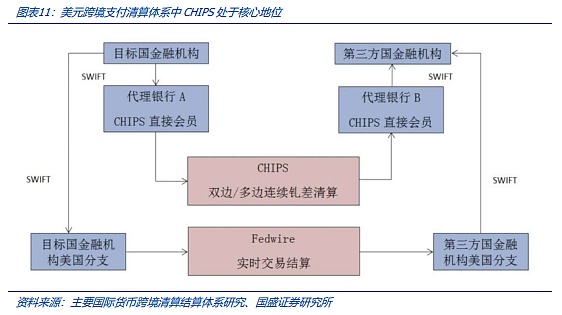
Therefore, the US dollar stablecoin issued on the blockchain is not subject to regulatory constraints, and the United States cannot control its liquidation. In the previous description, we can see that the blockchain ledger is naturally resistant to regulation and censorship. Therefore, the US dollar stablecoin is equivalent to the "offshore" US dollar. This is an unavoidable concern in the development of stablecoins. The United Nations Office on Drugs and Crime (UNODC) once released a report in January 2024 stating that the US dollar stablecoin USDT has become the main tool for money laundering and fraud by criminals in Southeast Asia because it is easy to transfer and widely accepted. This is a microcosm of the offshoreization of the US dollar caused by USDT.
In short, the current status of stablecoins is that they are in the stage of application first and regulation at the same time. In any case, the application demand and business logic of stablecoins are basically mature. The regulatory policies of the United States and Hong Kong authorities will only play a regulatory role in the development of stablecoins, and provide a clearer business development logic for traditional financial institutions.
6. Investment advice: Pay attention to RWA and stablecoin related sectors
We believe that driven by the regulatory bills related to stablecoins in the United States and Hong Kong, China, the RWA and stablecoin markets will usher in rapid development. Stablecoins and RWA are still mainly thematic investments. The market should pay attention to the landing of applications such as the tokenization of US stocks and the issuance of stablecoin licenses in Hong Kong, China. It is recommended to pay attention to targets related to the RWA and stablecoin industry chain. At the same time, for innovative applications native to the blockchain, attention should be paid to their catalysis and transformation of the financial market.
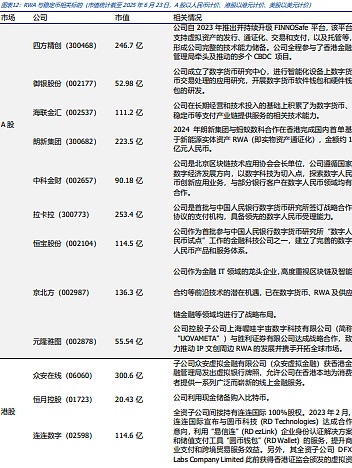
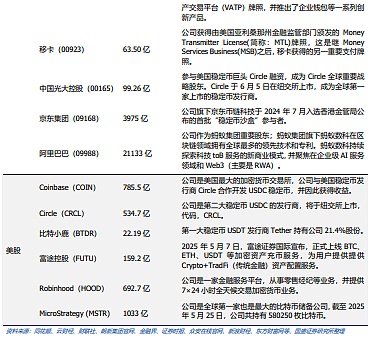
7. Risk Warning
Blockchain technology research and development is not as good as expected: The blockchain-related technologies and projects underlying Bitcoin are in the early stages of development, and there is a risk that technology research and development will not be as good as expected.
Uncertainty of regulatory policies: The actual operation of blockchain and Web3.0 projects involves a number of financial, network and other regulatory policies. At present, the regulatory policies of various countries are still in the research and exploration stage, and there is no mature regulatory model, so the industry faces the risk of uncertainty in regulatory policies.
Web3.0 business model implementation is not as expected: Web3.0 related infrastructure and projects are in the early stages of development, and there is a risk that the business model implementation will not be as expected.
 Kikyo
Kikyo
















